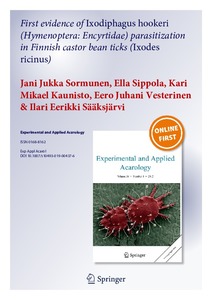First evidence of Ixodiphagus hookeri (Hymenoptera: Encyrtidae) parasitization in Finnish castor bean ticks (Ixodes ricinus)
Sormunen Jani Jukka; Sippola Ella; Kaunisto Kari Mikael; Vesterinen Eero Juhani; Sääksjärvi Ilari Eerikki
https://urn.fi/URN:NBN:fi-fe2021042824007
Tiivistelmä
Ixodiphagus hookeri (Hymenoptera:
Encyrtidae) is a parasitoid wasp specialized in parasitizing the larvae
and nymphs of ticks (Acari: Ixodidae). As parasitized ticks die prior to
reproduction, I. hookeri is seen
as a prime biological control agent candidate. Despite this, little is
known of their occurrence or ecology in northern Europe. The main aim of
the current study was to determine whether adult wasps or parasitized
ticks can be found from a tick-infested island in southwestern Finland,
using field collections and molecular methods. Following the initial
discovery of an adult I. hookeri
female on Seili Island, we set out to collect further specimens via
sweep netting and Malaise trappings between May and October 2017.
Furthermore, 1310 Ixodes ricinus (1220 nymphs, 90 adults) collected from the island during 2012–2014 were screened for I. hookeri DNA using qPCR. Whereas no further wasp specimens could be collected via sweep netting or Malaise trappings, I. hookeri DNA was consistently detected in I. ricinus
nymphs (annual minimum infection rates in 2012, 2013, and 2014: 2.3,
0.4, and 0.5%, respectively), whereas all adult samples were negative.
Although the annually repeated detections of parasitized ticks suggest
that the wasp inhabits the island, further field and molecular surveys
are needed to more comprehensively determine the status and stability of
the population.
Kokoelmat
- Rinnakkaistallenteet [27094]
